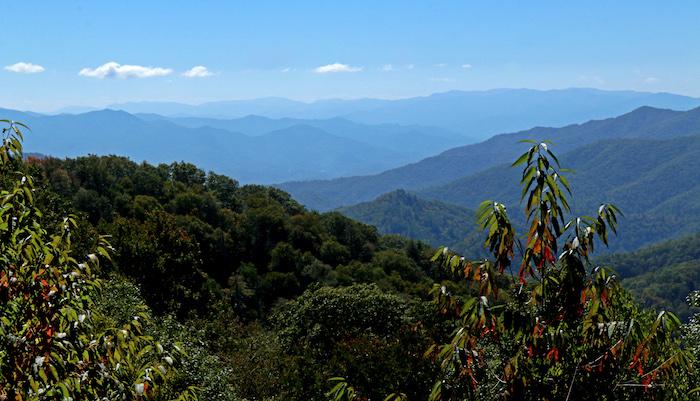
The rumpled landscape of Great Smoky Mountains National Park is seen as one link to a north-south corridor along the Eastern Seaboard that would aid movements of flora and fauna/Erika Zambello
Standing along the Blue Ridge Parkway in North Carolina, staring out over the overlapping peaks of Great Smoky Mountains National Park, I was wrapped in the seasonal hues of orange, red, and yellow donned by nearby trees. Cars buzzed past, the parkway acting as a beautiful connector within the larger transportation system. The protected area not only aids human travel, but is a critical component of the Eastern Wildway.
Ecologists have long recognized the importance of linkages between critical wildlife habitat regions. Now the Wildlands Network has emerged as a leader in establishing north-south corridors in the Northeast and western half of the United States and Canada. The need is obvious: migratory animals care little for political boundaries around states, national parks, and other reserves. When these wild regions are isolated, flora and fauna struggle to move freely between them, and the fragmented habitat cannot sustain healthy populations.
The Wildlands’ strategy is straightforward: protect, manage, and connect “core reserves” through natural corridors. The land I gazed over in Great Smoky Mountains is one of these core reserves, large enough to provide havens to bears and other large carnivores in addition to migrating birds, elk, rare salamanders, and so much more. Yet the challenges faced by the Smokies are emblematic of other national parks— Everglades in Florida, Shenandoah in Virginia, even Katahdin Woods and Waters National Monument in Maine—that are anchors of the corridor.
National parks receive a lot of visitors every year. Great Smoky saw more than 11 million people crowd through its entrances in 2017 alone. Overuse of park facilities and the landscape can lead to degradation. Plus, many of the core reserves are near population centers (Shenandoah is but 75 miles from Washington, D.C.) and are at risk for the effects of creeping development.
“And with a growing number of Easterners building first or second homes in relatively wild places,” the WN says, “people are collectively destroying the natural environments and solitude they seek.”
There is ongoing research to pinpoint corridor hotspots that need protection. For example, Interstate 40 separates Great Smoky from nearby national forests, hampering migration of a variety of species.
Using GPS and camera traps along roads, teams are working to identify corridor crossings. Road-kill surveys also help pinpoint areas where wildlife bridges could be built to allow unfettered movement in and out of this section of the national park.
Such an approach has been successful in Florida’s Paynes Prairie Preserve State Park. A barrier wall-culvert system reduced recorded annual wildlife deaths from 2,411 to just 158. More than 50 vertebrate species use the culverts, including fish, frogs, alligators, turtles, snakes, armadillos, shrews, rats, raccoons, and rabbits.
When private land can be used to enhance the Eastern Wildway, the WN works with local land trusts or national nonprofit organizations to either purchase the land directly or arrange conservation easements to facilitate wildlife migrations.
A proposed National Wildlife Corridors bill would provide a federally recognized “corridor” designation, which could be used to both highlight areas where management must not impede wildlife migration (such as building pipelines or mining) and/or focus federal funding on purchasing land or easements in identified corridor areas.
Already, the Essential 16 Wildlife Habitats have been identified to improve connectivity in the North and Southeast. Near Great Smoky, stakeholders are working to protect a dozen miles between two protected areas, including the park and national forests.
“Restoring this connection would enable wide-ranging species to move across a vast network of ridge tops and deep forest coves,” the WN team writes.
New national parks could further enhance the corridor; the envisioned High Allegheny National Park in West Virginia could encompass 500,000 acres.
If fully connected, the Eastern Wildway would link nearly half of land and water in eastern North America, encompassing habitats of black bear, bobcat, timber rattlesnakes, and box turtles in the southern Appalachians, eastern diamondback rattlesnakes, red wolves, Florida panthers, and gopher tortoises in the Southeastern coastal plain, as well as moose, lynx, fishers, martens, and eastern wolves in the northern Appalachians.
Large protected areas are beneficial to humans as well. As I sat on a ridge beneath Clingmans Dome, the surrounding trees, birdsong, and mountain vistas instantly relaxed me. My breathing slowed and deepened, my mind cleared. “In wilderness,” notes the Wildlands Network, “we find solitude, spiritual renewal, and a quiet setting for backcountry recreation.”

Camera traps help researchers keep track of the wildlife, such as this red wolf, that are in the region and in need of safer travel corridors/Wildlands Network







Comments
Thank you for giving the Eastern Wildway favorable attention, National Parks advocates. Expanding and reconnecting parks is among top priorities for protecting an Eastern Wildway. I had the privilege of trekking the proposed Eastern Wildway in 2011, guided by Wildlands Network and Rewilding Institute leaders; and we summarized our findings in the book BIG, WILD, AND CONNECTED: Scouting the Eastern Wildway from Florida to Quebec. With you for our wild neighbors; John Davis, Rewilding Earth editor (rewilding.org)
Thanks Erika and National Parks Traveler for covering the Eastern Wildway! It is a bold and optimistic vision, one that we as a civilization could choose to pursue if we'd like to live in a place where natural areas are connected and where biodiversity isn't always on the brink of extinction.
Ron Sutherland, Wildlands Network